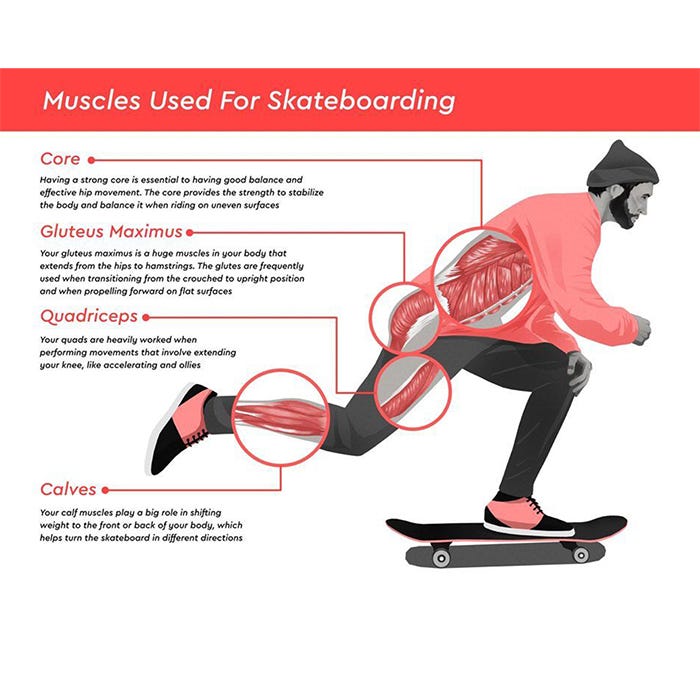Keeping fit with Skateboarding
Skateboarding is a great form of exercise, skateboarding can help improve your balance and coordination, and it is also a great way to burn calories. Skateboarding is an amazing cardio workout that gets your heart and blood pumping, skating works your heart in a similar way a high-intensity workout does. Even cruising on a skateboard boosts the cardiovascular system.
Skateboarding uses a ton of muscles the most used muscles include the Core, quadriceps, hamstrings, gluteus maximus, calves and the tibialis anterior muscle.

Core Muscle
Your core muscles play a huge role in balancing your body on unstable surfaces, which is a vital component in skateboarding. You use your core in all aspects of skating street and park skating because balance is a huge part of skating, so for those six-pack abs, there’s nothing better!
Quadriceps Muscles
The quadriceps consists of four individual muscles, they form the main bulk of the thigh and collectively are one of the most powerful muscles in the body. They help you extend your knee and contract your hip joint, which is required anytime you jump, such as the ollie in skateboarding.
Hamstring Muscles
The hamstring muscles are used to flex the knee joint and extend the hip, which allows you to bring your calves up toward the back of your thigh. Flexing your knee is important for crouching down to maintain a lower center of gravity while skating.
Gluteus Maximus Muscle
The main functions of the gluteus maximus muscle are the extension and external rotation of the thigh at the hip joint. This muscle helps you keep your balance when you switch from squatting to standing on the skateboard.
Lower Leg Muscles
Your lower leg muscles include your calves and the tibialis anterior muscle around your shins. Skateboarders rely on the calve muscle for plantar flexion of the ankle, which points your toes downward. Planter flexing allows you to shift your weight toward the front of your body, which helps turn the direction of a moving skateboard in that direction. The tibialis anterior muscle, which forms your shins, controls dorsal flexion. Dorsal flexion allows you to tilt your heels downward while skateboarding, which provides directional control in the opposite direction of plantar flexion.
Not only is skateboarding a great exercise but skateboarding can help you improve your precision and coordination. The learning curve can be a struggle but in the long run, your improved coordination can help you with multitasking, driving, other sports, and daily activities in general.
Strength Training in Skateboarding
Strength training it’s not necessary to get better at skateboarding, it can help improve your skills and endurance in ways that skateboarding alone cannot. When performing a trick, it takes a decent amount of strength and energy to pop the board off the ground, so the stronger you are, the higher you can jump. Strength training can also increase your endurance, allowing you to skate for longer intervals and minimise injury from muscle fatigue. Some exercise you can do to improve strength is Lateral Leg Raises, Box Jumps, Single Leg Squats and Side Plank.
So there we go! Skateboarding is brilliant for your physical health as well as your mental health. All the more reason to pick up that board and get out there. Stay safe and happy cruising!
Browse our entire range of skateboards including adults and kids skateboards.


